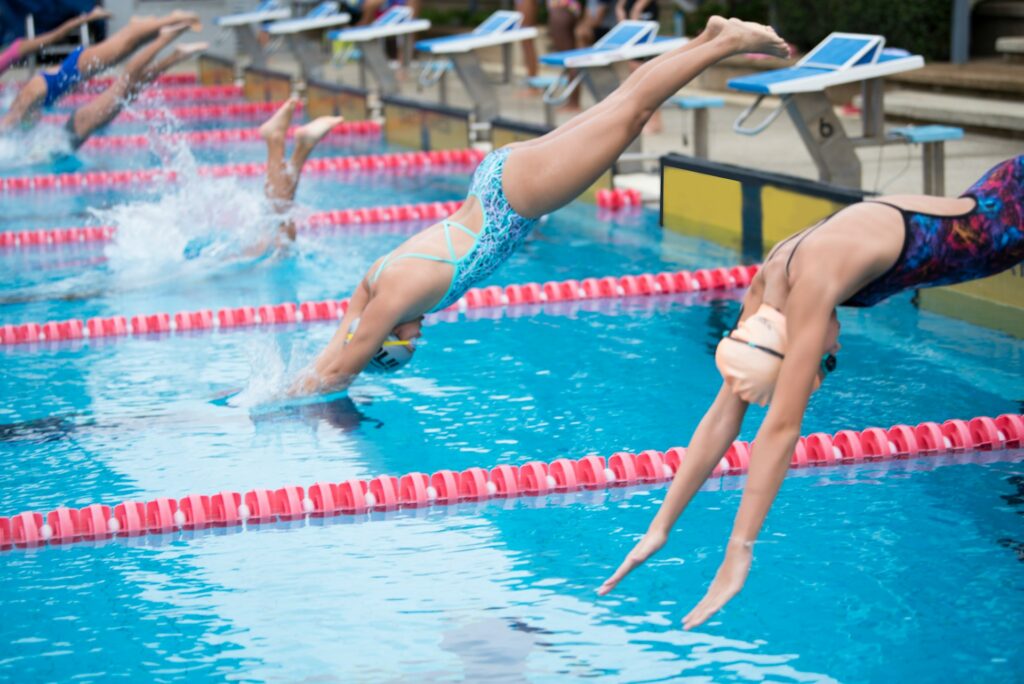Learn about What Is Circle Swimming. Circle swimming is a shared lane technique where swimmers move in a loop, promoting flow and safety. Learn tips, rules, and habits for smooth, effective swimming.
Circle swimming refers to swimming side by side in the same lane where there may be numerous swimmers swimming in one direction, usually counterclockwise, in a continuous loop. In the circle swimming system, one swimmer will be heading to one side of the pool and returning toward a teammate who is heading in the opposite direction. The system allows more swimmers to occupy one lane without interfering with one another’s rhythm.
What Is Circle Swimming?
Circle swimming is a method of swimming in a shared lane where multiple swimmers swim in the same direction, typically counterclockwise, in a continuous loop. Instead of splitting the lane down the middle, swimmers follow each other in a circular pattern—up one side of the lane and back down the other. This system allows more swimmers to occupy a single lane without interfering with one another’s rhythm.
5 Circle Swimming Tips
1. Leaving the Wall
Always start your swim at least five seconds after the swimmer in front of you has begun to swim. This time gap assists with maintaining the flow of swimmers ahead and prevents any accidental drafting or crowding, ensuring that the entire lane has a smooth swim experience.
2. Turns
Be quick on your turns and remain on the side of the lane when executing flip turns or open turns. Do not impede other athletes’ progress, especially on the wall, where perfect timing and position are essential to lane rhythm and efficiency.
3. Passing Etiquette
Gently tap the feet of the swimmer in front of you to indicate passing, and they should stop at the next wall to let you go. Do not pass a swimmer in the lane; it disrupts flowing conditions and increases the risks of collisions while circle swimming.

4. Be Courteous
Be courteous to your fellow swimmers by swimming at the speed set by the lane and being aware of traffic around you. Do not splash too much, do not come to a complete stop out of nowhere, and always be polite when entering or exiting a lane. Good manners make everyone pool experience better.
5. Swim Straight
It is important to swim along the designated side of the lane in a straight line. Zigzagging would cause disruptions and danger. Moving steadily and predictably is the best way to allow everyone in the lane to apply their energy productively and reduce the risk of mid-lane collisions.
Why Circle Swimming Creates Bad Habits
Lazy Turns
Swimmers sometimes go into turns that are too wide and laborious while circle swimming to avoid colliding with other swimmers. This can set the groundwork for bad turning habits that would hinder faster racing, where sharp and explosive turns are necessary.
Slow Streamlines
Circle swimming may help against strong push-offs and tight streamlines, especially when the lane is busy. Swimmers might pull back from a full extension or a good kick, thus reinforcing poor form that limits the swimmer’s fast, efficient habits in the long run.
Sloppy Technique
Fearing bumping into an obstruction often leads to a stroke imbalance. Frequent corrections mid-stroke and wide-arm positions lead to bad mechanics and rhythm, two technical faults that hamper advances and stultify swimming potential in the long run.
Head-Up Swimming
To prevent collision, swimmers often partake in raising their heads to check positions. This destroys the body alignment and flow, fostering an unnatural habit. This further leads to decreased efficiency and much slower strokes while inducing extra strain on the neck and shoulders.
Drafting
Circle swimming may encourage swimmers too closely to follow the feet of others, taking advantage of their drafting and thus preventing the development of healthy pacing. Drafting is an important skill that saves energy, yet developing a reliance on it erodes the self-regulatory skills crucial to swimming strong, independent races when it most counts.
Circle Swimming in Competitive Training
The practice of circle swimming is widely adopted in professional swim teams during drills, intervals, and warm-ups. It enables teams to complete workouts without wasting pool time. Coaches use circle swimming to set up race-like conditions in which swimmers must maintain pace, spacing, and awareness.
Is Circle Swimming Only for Competitive Swimmers?
Certainly not! Competitive swimmers often use circle swimming in training, but most often recreational swimmers, triathletes, and fitness swimmers will use it too. It is good for all lane users to understand the principle for a smooth swimming experience without misunderstandings.
Circle Swimming Rules and Etiquette
Here are some points that one must master in circle swimming:
1. Join the Lane Properly
Observe swimmers already in the lane before entering. Check desired speeds and ask whether or not it is okay to join them. Entry should also be to the same lane speed (slow, medium, or fast).
2. Follow the Circle Pattern
In the US and many other countries, swimmers generally swim in an anti-clockwise manner:
- Swim upwards on the right side of the lane.
- Now, turn and come back on the left side.
If you’re not sure, just ask a lifeguard or fellow swimmer about the local custom.
3. Maintain Consistent Pacing
Swim steadily with the flow of that lane. If it happens that there is a faster swimmer approaching you, stop at the corner edge of the wall immediately; this way, the faster swimmer can get by without having to worry about their passing being put off.
4. Respect Overtaking Rules
If you were faster, you would gently tap the toe of the swimmer ahead of you. The swimmer being tapped should yield to you by the next wall, moving into the corner so that you may pass uninterrupted and maintain flow in the circle.
5. Keep Turns Tight
When turning, do so sharply, very near to your side of the lane, not wandering into the middle or in an arc wide enough to distract other swimmers in the loop.
Pros of Circle Swimming
Maximizes Lane Usage
Circle swimming allows many swimmers to share a lane efficiently while swimming, providing a better use of pool space.
Encourages Pace Awareness
In turn, this allows swimmers to be cognizant of their pace concerning the other swimmers to maintain an easy rhythm and control throughout the practice.

Builds Situational Awareness
Swimming requires the ability to recognize the positions of others, which increases reaction time, awareness of the surroundings, and adaptability- all-important outgrowths for critical competitive environments.
Fosters Team Discipline
Discipline, cooperation, and respect for swimming etiquette are learned when maintaining a common rhythm and abiding by passing rules.
Mimics Race Pressure
Circle swim training replicates real racing conditions in which swimmers have to perform under pressure while avoiding distractions and reacting quickly to their fellow racers.
Conclusion
Circle swimming improves efficiency in a shared lane and has flow and safety for all swimmers. Although it creates discipline and awareness, it might cause some bad habits with a lack of form. If deduction or reasonable pace is applied to this neat swimming style, then competitive and recreational swimmers alike will enjoy this swimming style.
